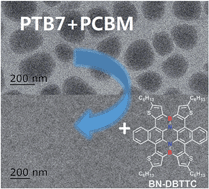Curved BN-embedded nanographene for application in organic solar cells†
Abstract
A BN-embedded polycyclic aromatic compound, BN-dibenzotetrathienocoronene (BN-DBTTC), is utilized for application in organic photovoltaic devices. Although BN-DBTTC has a large energy gap of 2.59 eV, the devices with PC71BM as the acceptor show a power conversion efficiency (PCE) of up to 3.12% at a donor–acceptor (D–A) molar ratio (MR) of 1 : 4. An open circuit voltage (Voc) of 0.96 ± 0.01 V is achieved at a MR of 1 : 2. The high Voc is ascribed to the lowered HOMO level by introducing BN units into the π-system and the supramolecular interaction between the curved π-surface of BN-DBTTC and PC71BM. Moreover, BN-DBTTC is added to a PTB7:PC71BM device to control the morphology of the blend film, showing increased PCE and enhanced stability by suppressing the crystallization of PCBM. After BN-DBTTC is introduced, the domain size is reduced from ∼200 nm to well below 20 nm. At a weight ratio of PTB7 : BN-DBTTC : PC71BM = 8 : 3 : 12, the PCE is enhanced from 3.91% to 4.75%, and the PCE degradation is reduced from 47.8% to 26.7% after 20-month storage. BN-DBTTC is better than 1,8-diiodooctane (DIO) as the PCBM aggregation inhibitor in terms of process simplicity because as a photoactive material, BN-DBTTC doesn't need to be removed after processing.


 Please wait while we load your content...
Please wait while we load your content...